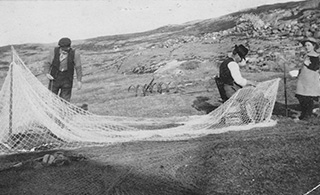There once stood a simple log cabin on the Refsnes oceanfront. In the cabin, men sat patiently waiting for the salmon to enter the bay. This was the vorp, an ancient fishing method which is also called ståarnot or sitjenot, meaning sitting net, because you sit, waiting and scouting for salmon.
In the sea below the cabin on the cape lay the funnel-shaped nets. The rock beneath was whitewashed to fool the fish into entering the nets, thinking they had found a waterfall. The white rock also made it easier to spot the salmon. Once the salmon appeared, you had to act quickly and trap the fish inside by tugging at the net. But the line shouldn’t be closed prematurely. Salmon travel in schools, so it was important to trap as many as possible with one tug.
One day in June 1900, Ole Bedin Refsnes is standing on a crag called Kaukarberget. The week’s salmon fishing has been extraordinary. Ole shouts messages towards the farm. When fish were caught in the nets or there was other news to report, you had to use your voice and bellow towards the farm. This was long before mobile phones.
The vorp was still used in the summer of 1900. But most of the salmon was caught using kilenot, meaning wedge net, a newer method which was used from the mid-1800s. The wedge net was more efficient and less time consuming. Once the salmon had swum into the net, it could not escape. There was no need to wait and scout for fish.
The fishing rights have been an important privilege which provided good subsidiary income for the Refsnes farm. That there was money to be made can be observed in the land register of Aslak Bolt, which specifies that the Hospital in Trondheim received income from here in the 1400s. However the amounts rose substantially with the introduction of the wedge net. When production was at its peak around the beginning of 1900, the farm owner could make good money selling fish to buyers in Trondheim. On a receipt from trader Marentius Thamshavn dated June 6th 1900, we see that Ole Bedin Refsnes received 270 crowns for a week’s catch! Self-produced ice from the local ice pond kept the fish cool on its voyage to the city.
Today the vorp is gone, but fishing remains an important source of income for the farm at Refsnes, now as a result of the tourist industry. Keen fishermen come here from Germany and other European countries with their own dreams of catching the big one.


One comment
Leave a reply